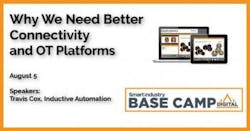Properly connected industrial systems? Great! But how do you achieve it?
As industrial systems grow more complex, maintaining proper connectivity within/between them gets tricky. Here, find expert guidance from Kent Melville, Inductive Automation sales engineering manager, who explores the need for enhanced connectivity, the role of OT platforms, and the traits of a properly cohesive industrial environment. Take a look…
Smart Industry: Why do we need better connectivity in our industrial systems? How do we achieve this?
Kent: The amount of data being generated has grown exponentially over the past decade. Legacy networks, protocols and software weren't built with this scale in mind. In order to take advantage of the increased visibility into your environment, you need devices that support modern protocols (open, secure and efficient), the network infrastructure to support the bandwidth, and the software to understand this data and do something meaningful with it.
Kent: OT platforms excel at connecting to a wide variety of existing equipment and getting the raw data. They can also be used to standardize the data format and provide context before passing it up to IT-focused solutions.
Smart Industry: What are the traits of a cohesive, productive environment?
Kent: For an environment to be cohesive and productive, it all starts with standardization…standardization as close to the plant floor as possible. Trying to piece through amalgamated data and find actionable results via cloud services can be a daunting and expensive undertaking. OT platforms allow for reorganizing the data closer to the source, which enables the creation of standard structures and models. Better yet, standards can be enforced at the PLC layer with consistent programming and protocols.
Smart Industry: What is one example of implementing an OT-first mindset in a digital transformation?
Kent: Focusing on device connectivity from the start. Too often people start by saying, “With centralized data we are going to accomplish X, Y and Z.” They may even find tools that tout accomplishing X, Y and Z. The elephant in the room is that these tools all start with the assumption that data magically appears, and is in a standard, usable format. OT-first starts with real devices, real data, and makes sure you have a real infrastructure on which to build.

